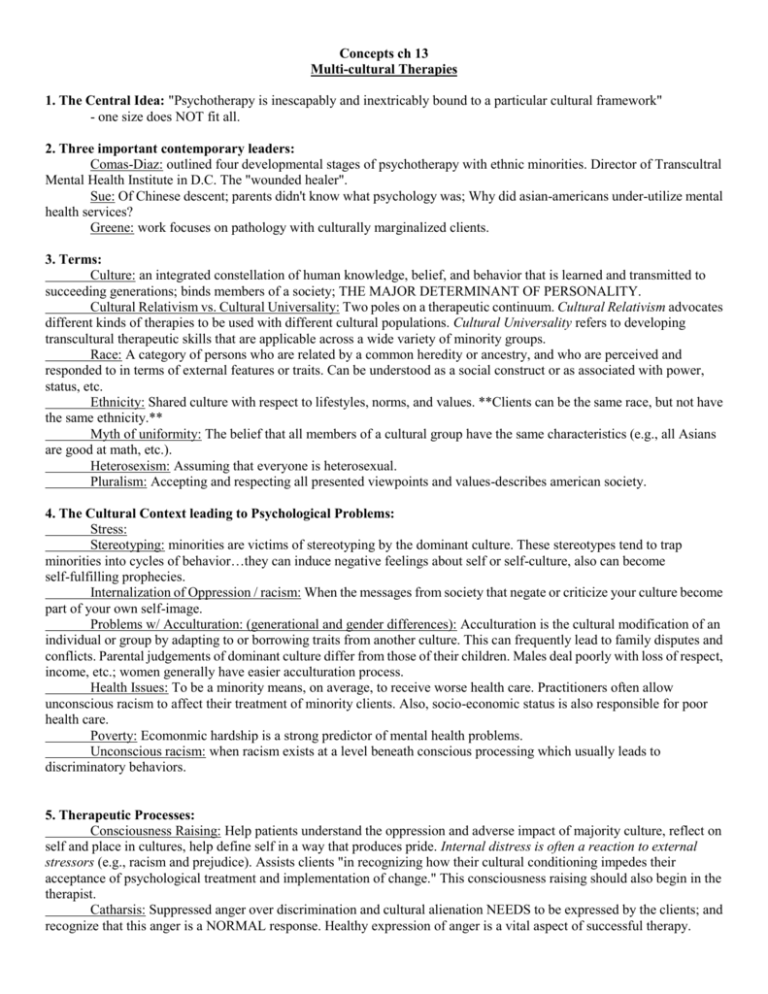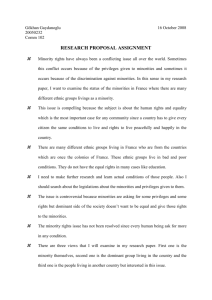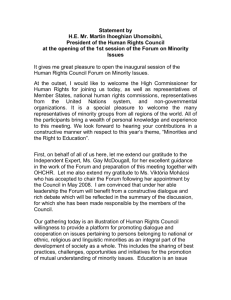Concepts ch 13
advertisement

Concepts ch 13 Multi-cultural Therapies 1. The Central Idea: "Psychotherapy is inescapably and inextricably bound to a particular cultural framework" - one size does NOT fit all. 2. Three important contemporary leaders: Comas-Diaz: outlined four developmental stages of psychotherapy with ethnic minorities. Director of Transcultral Mental Health Institute in D.C. The "wounded healer". Sue: Of Chinese descent; parents didn't know what psychology was; Why did asian-americans under-utilize mental health services? Greene: work focuses on pathology with culturally marginalized clients. 3. Terms: Culture: an integrated constellation of human knowledge, belief, and behavior that is learned and transmitted to succeeding generations; binds members of a society; THE MAJOR DETERMINANT OF PERSONALITY. Cultural Relativism vs. Cultural Universality: Two poles on a therapeutic continuum. Cultural Relativism advocates different kinds of therapies to be used with different cultural populations. Cultural Universality refers to developing transcultural therapeutic skills that are applicable across a wide variety of minority groups. Race: A category of persons who are related by a common heredity or ancestry, and who are perceived and responded to in terms of external features or traits. Can be understood as a social construct or as associated with power, status, etc. Ethnicity: Shared culture with respect to lifestyles, norms, and values. **Clients can be the same race, but not have the same ethnicity.** Myth of uniformity: The belief that all members of a cultural group have the same characteristics (e.g., all Asians are good at math, etc.). Heterosexism: Assuming that everyone is heterosexual. Pluralism: Accepting and respecting all presented viewpoints and values-describes american society. 4. The Cultural Context leading to Psychological Problems: Stress: Stereotyping: minorities are victims of stereotyping by the dominant culture. These stereotypes tend to trap minorities into cycles of behavior…they can induce negative feelings about self or self-culture, also can become self-fulfilling prophecies. Internalization of Oppression / racism: When the messages from society that negate or criticize your culture become part of your own self-image. Problems w/ Acculturation: (generational and gender differences): Acculturation is the cultural modification of an individual or group by adapting to or borrowing traits from another culture. This can frequently lead to family disputes and conflicts. Parental judgements of dominant culture differ from those of their children. Males deal poorly with loss of respect, income, etc.; women generally have easier acculturation process. Health Issues: To be a minority means, on average, to receive worse health care. Practitioners often allow unconscious racism to affect their treatment of minority clients. Also, socio-economic status is also responsible for poor health care. Poverty: Ecomonmic hardship is a strong predictor of mental health problems. Unconscious racism: when racism exists at a level beneath conscious processing which usually leads to discriminatory behaviors. 5. Therapeutic Processes: Consciousness Raising: Help patients understand the oppression and adverse impact of majority culture, reflect on self and place in cultures, help define self in a way that produces pride. Internal distress is often a reaction to external stressors (e.g., racism and prejudice). Assists clients "in recognizing how their cultural conditioning impedes their acceptance of psychological treatment and implementation of change." This consciousness raising should also begin in the therapist. Catharsis: Suppressed anger over discrimination and cultural alienation NEEDS to be expressed by the clients; and recognize that this anger is a NORMAL response. Healthy expression of anger is a vital aspect of successful therapy. Choosing: Once acknowledged their oppression and expressed anger, they must CHOOSE how to channel their new-found liberation and pride constructively. A critical choice: How to integrate their sense of self with their cultural group? What parts of majority culture to assimilate? What parts of self culture to maintain or reject? 6. Therapeutic Content: (note the new definitions of the following) Intimacy: Intimacy lies in the deep bonds of family and cultural groups. Loss of this intimacy is a key problem in culturally marginalized clients. Communication: Communication problems can exist between dominant culture and minority culture (prejudice, biases) and also within cultures. Communication fails when differences between groups and individuals are given more weight than their similarities. Hostility: Is the "expected reaction to years of discrimination and self-depreciation." "Anger is a natural reaction to oppression." The balance: validating outrage while discouraging destructive hostility. Control: Struggle to fight being controlled by messages and discrimination in society. Establishing greater opportunities for individuals and groups. 7. Therapeutic Bond: Clinician empathy, positive regard, and collaboration are the foundation of multicultural therapy; listen, support, and validate. The goal is to join the client whereever he/she is: depending on client's cultural values, the relationship will take a congruent form. Advocacy: empowering the clients for social change-the therapist, while working with the individual is also working to change society. 7a. Practicalities: The treatment format will depend on the culture of the particular client. Therapists tend to develop a network of change agents that will reverberate throughout the client's life. Typically involved more than a single patient; involves contact with families and entire communities (including contact with indigenous healers). Also, implement pre-therapy prep in order to decide upon an agreed mode of therapy. 8. Research: Many racial and ethnic minorities are underserved in the mental health arena. Ethnically similar therapists are preferred by members of racial minority groups. Research fails to demonstrate that ethnic minority therapists achieve better or worse outcomes. Few controlled studies done on effectiveness of culturally diverse therapy. Not adequately tested for their effectiveness with members of minority cultures and sub-cultures. No randomized clinical trials have been conducted. The gap b/w research and practice is acute for racial and ethnic minorities. 9. LGBT clients Commonalities w/ other minorities: stereotypes, discrimination, trauma, internalized oppression, stress, anxiety, depression, and substance abuse. 10. Opinion of authors on Reparative Therapy: - Reparative therapy is therapy that attempts to fix the "problematic" sexual orientation of LGBT clients. They call it the "opposite of affirming the identity of the clients". Widely discredited, and evidence suggests possible negative therapeutic outcomes. APA discourages practicitioners from attempting to change clients' sexual orientations. 11. Central Processes: 1. Consciousness Raising: same as multi-cultural consciousness raising; teach clients of the biases and discrimination that they might have internalized; their emotional response to life is normal considering the societal controls placed upon their identity. 2. Catharsis: Allowing corrective expression of repressed anger and hostility. 3. Choosing: Giving clients the ability and responsibility to choose the orientation that they want and choosing to change society in order to make the lives of LGBT people less discriminated. 12. Therapeutic Relationship: central in this type of therapy; even more so than other systems of psychotherapy-- "A warm, supportive, unconditionaly respectful relationship ameliorates the detrimental effects of decades of oppression and invalidation." Empathy and acceptance are the "core" of "working with LGBT clients." 14. Pluralism, tolerance, celebration. 15. Multicultrual Competence: -- A. What are the things we should be ADDRESSING with clients (and ourselves) to be cultrually aware and culturally-sensitive? Being culturally sensitive involves, at its core, not making assumptions about the client's values and their congruence with yours. You should be aware of your own cultural and sexual values and know that these will come into play in your interactions with your clients. However, it is not your culture that should be the foci of the therapy, but the culture of the client. It is what the CLIENT believes, wants, etc. that is of central concern. If the client values reserve, solemnity, etc., one should n be attempting to make them the ideal outgoing person.





